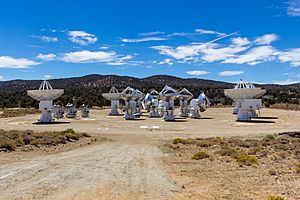Combined Array for Research in Millimeter-wave Astronomy facts for kids
 |
|
| Alternative names | CARMA |
|---|---|
| Part of | Owens Valley Radio Observatory |
| Location(s) | California |
| Coordinates | 37°16′49″N 118°08′31″W / 37.2804°N 118.142°W |
| Organization | California Institute of Technology |
| Altitude | 2,196 m (7,205 ft) |
| First light | 2005 |
| Telescope style | radio interferometer |
| Website | www |
The Combined Array for Research in Millimeter-wave Astronomy (CARMA) was a special observatory. It used 23 large radio telescopes working together. It started in 2006. These telescopes worked like one giant telescope. They combined their signals using a special computer. This helped them create very clear pictures of space.
CARMA stopped working in April 2015. Its telescopes were then moved to the Owens Valley Radio Observatory for storage. Today, the Atacama Large Millimeter Array in Chile is the most powerful millimeter-wave telescope array in the world.
| Top - 0-9 A B C D E F G H I J K L M N O P Q R S T U V W X Y Z |
Where Was CARMA Located?
CARMA was built high up in the Inyo Mountains in California. It was located at a place called Cedar Flat. This spot is east of the Owens Valley Radio Observatory.
The observatory was about 2,196 meters (7,205 feet) above sea level. Scientists chose this high location carefully. It helped them avoid problems from water vapor in the air. Water vapor can block or distort the signals from space.
What Made CARMA Special?
CARMA was unique because it used different types of radio telescopes. They came in various sizes and designs. All of them were Cassegrain reflector antennas. This means they used special mirrors to focus radio waves.
There were three main types of telescopes at CARMA:
- Six large telescopes: Each of these was 10.4 meters (34 feet) wide. They were originally part of the Millimeter Array at the Owens Valley Radio Observatory. They moved to Cedar Flat in 2005.
- Nine medium telescopes: These were 6.1 meters (20 feet) wide each. They used to be at the Hat Creek Radio Observatory. They also moved to Cedar Flat in 2005.
- Eight smaller telescopes: Each of these was 3.5 meters (11.5 feet) wide. They were built for studying the early universe. They are also known as the Sunyaev-Zel'dovich Array (SZA). The SZA joined CARMA in 2008.
How Did CARMA Work?
By November 2006, the 10.4-meter and 6.1-meter telescopes were working together. They collected important scientific data.
CARMA could spread its telescopes out over 2 kilometers (1.2 miles). This allowed it to see the smallest details in space. But over such long distances, water vapor in the air could make images blurry.
To fix this, CARMA used a clever trick. It placed a small SZA antenna near each main CARMA antenna. These small antennas watched a bright radio source nearby. This helped them measure how much water vapor was in the air. This information was then used to clean up the images. This way, scientists could get much clearer views of space.
The SZA telescopes also helped CARMA directly. They worked together to observe space at different radio frequencies.
What Did CARMA Observe?
CARMA mainly observed radio waves in two ranges:
- The 3-millimeter range (80–115 GHz)
- The 1-millimeter range (210–270 GHz)
These frequencies are great for finding many types of gas molecules in space. One important molecule it looked for was carbon monoxide (CO). Finding CO helps scientists find hydrogen gas. Hydrogen is the most common molecule in the universe, but it's hard to see directly.
CARMA also studied cold dust. This helped scientists learn about how planets form around stars. For example, it could see disks of dust and gas where new planets might be growing.
CARMA and the Event Horizon Telescope
CARMA was an important part of the early work for the Event Horizon Telescope project. In 2007, CARMA helped with observations that showed something amazing. It helped scientists see structures near the supermassive black hole at the center of our Milky Way galaxy, called Sgr A*. These structures were as small as the black hole's event horizon.
Who Was Involved with CARMA?
CARMA was a team effort. Several universities and research groups worked together on the project:
- California Institute of Technology
- University of California, Berkeley, Radio Astronomy Laboratory
- University of Chicago
- University of Illinois at Urbana-Champaign, Laboratory for Astronomical Imaging
- University of Maryland, College Park, Laboratory for Millimeter-wave Astronomy
See Also
- Owens Valley Radio Observatory
- Atacama Large Millimeter Array
- Sunyaev–Zeldovich effect
- Radio astronomy
- Interferometry



